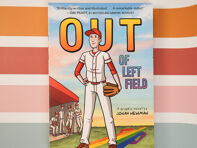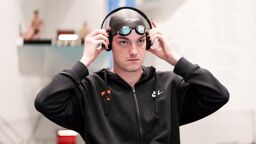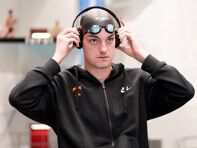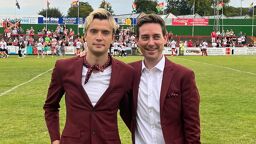That storied strip of barrier beach along the south shore of Long Island has long been a good place to get away from it all — to party, to get laid, to enjoy nature and good seafood …and to run. My own running there started around 1971, when I was still married and in the closet. Some friends had a beach house in Davis Park and often invited my husband and myself to spend weekends with them.
From the Long Island shore, as a person takes the ferry for the first time, Fire Island appears as a long undulating greenish line along the southern horizon of the Great South Bay. In those days, the two ferries operating out of Patchogue were Fire Island Queen and Quaiapen. On any given day, the ferries would churn their broad wake through hundreds of clamboats dotted across the bay, each with a lone man on the prow, working his long clam rake. Tong boats were hard at work too, with the digger by the gunwhale with his long tongs, feeling for oysters below. This great fishery supplied 50 percent of the quahog clams consumed by Americans.
The breezy trip to that horizon, as you stand on the deck with your hair whipping in the wind and the engines thrumming under your feet, convinces you that you’re voyaging to the edge of the known world, where the ancient maps warned that “here there be dragons.” No matter how many times you ride the ferry, you still get that feeling of delightful remoteness and hope for inner peace.
In fact, I was to learn that Fire Island is not one remote world, but many, with layers of human identities running through its textured, and sometimes dark, history. Its timeline runs from the Native American tribes that once lived and fished there, to the big-city weekenders and day-trippers who flood there today. From the 19th Century slavers who trafficked through there (slavery was still legal in New York then), to the LGBT seekers for freedom of today. The timeline also embraces the history of South Shore families who have worked the bay for many generations and call themselves Bonackers.
The Bonackers I knew were tough, independent, hardworking, with an ethic that reminded me of the Montana cowboys among whom I grew up. They referred to Fire Island as the Great South Beach — “the Beach” for short. Even they regarded the Beach as a place of refuge. Often I heard them say that “going on the Beach was the best way to get away from mainland bullshit.”
I was 35 then, with a first novel just published, and three years of running already behind me. Running had always attracted me, though school girls were not encouraged to go out for running sports when I was a kid. But in 1971, with jogging and long-distance running now a national trend, I was making up for lost time. One of the newer members of the Road Runners Club of America, I had run unofficially in a few long-distance races, notably the 1969 Boston Marathon, as one of a growing group of female athletes who were fighting to be officially recognized in U.S. long-distance running. That year, in 1971, I had also competed in the New York City Marathon, the first race in which women marathoners could enter officially. I had placed fourth in the women’s division with a 4:45.

The Quaiapen landed us on the dock at the Davis Park marina. In those days, Davis Park was a known haven for heterosexual “swinging singles” weekend blasts by young career New Yorkers. Dating dramas ranged from the beach houses and marina houseboats to the Leja Beach Casino, a weatherbeaten restaurant and bar, definitely an old-school spot to dine and dance, its jukebox loaded with pop rock. Drinkers at the Casino bar often included clammers who hung out at the Davis Park marina.
But Davis Park’s fame was overshadowed by that of Cherry Grove and Fire Island Pines, those two rollicking communities for LGBT blasts, so amply supplied with elegant homes, bars, clubs and eateries, that sit just a few miles west of Davis Park. Fire Island’s Wikipedia write-up waxes poetic as it states: “According to legend, the gay population began to concentrate in Cherry Grove at Duffy's Hotel with Christopher Isherwood and W. H. Auden dressed as Dionysus and Ganymede and carried aloft on a gilded litter by a group of singing followers. The gay influence was continued in the 1960s when male model John B. Whyte developed Fire Island Pines.”
I was aware of the growing urgency within me that it was time to shed the fake hetero marriage and come out. But being out for real, and making my first visit to the Pines and the Grove, were not quite possible yet.
In 1964, most of the Beach had been taken over by the National Park Service, to become the Fire Island National Seashore. There had been growing concern to protect this unique strip of American natural beauty. Fierce battles had already been fought – notably by activists who stopped construction of a highway the full length of the Beach. Exceptions to federal takeover were made for communities legally organized as villages or hamlets. (Cherry Grove and Fire Island Pines were among those.) If your beach house wasn’t located in one of those exceptions, you were expected to sell your property to the feds. Your other option was to forego sale and get “time” – a few additional years before you had to vacate. This touched off more legal battles.
Sightseeing While Running
Shortly, during my first workouts, I’d made my own discovery that Fire Island is a paradise for runners – a place that helped you test yourself.
The miles of grassy windswept dunes were dotted with pungent patches of creeping pine. In spring they were tinged in pink and white with beach plum and bayberry in bloom – in fall, they changed into fiery hues of changing foliage. Behind the belt of dunes, along the bay side, whitetail deer could be glimpsed amidst the groves of wind-bent trees. Ancestors of these deer had gotten there from the mainland by trekking across the frozen bay in winter.
Irresistible to a barefoot runner, the long stretch of beach unreels for 30 miles, from the more populated west end (nearer New York City) to the largely empty east end where the Smith Point Bridge links to the Long Island mainland. Running barefoot in the sand does wonders for fitness and endurance. In those early workouts, I usually did 2 ½ miles out and 2 ½ back, with a 10 or 12 miler on weekends. My marathon times were stuck in the plodder range — a PB of 4:20 in the Boston — so I aimed to train hard enough to break 4 hours.
Those workouts gave me more sights to enjoy than sea birds pecking in the wash for food. Some sights told silent stories of Fire Island history. Amethyst bits of colonial bottle glass flecking the beach were a reminder of how, in the 1700s, the British crown granted ownership of the island to colonist William Smith. A few tiny communities sprang up in the 1800s, notably Long Cove, where a few local families lived year round — a hard life in their weathered little houses perched on pilings. The pilings may have been a Bonacker invention, to let wind and sand blow freely under the house so a dune didn’t form against it. Houses on stilts became the signature architectural style for Fire Island.
Just east of Long Cove, in the fall, a runner could stop to inspect the rusted keel and boilers of a ship half buried in the sand. Since colonial times, hundreds of sailing ships and steamships had grounded and broken apart in storms along that shore while heading to or from New York harbor. Covered by sand most of the year, this one was bared every fall by erosion of the beach. Its cargo might have been looted by residents who made their living by scavenging shipwrecks. Dead sailors who washed up on the beach were said to be buried in lonely graves in the dunes. The ghost of one sailor, known as Whistling Sam, was said to haunt the dunes.
Farther east, on my run, I could ponder Whalehouse Point and its vestiges of a 1700s whaling station. If I ran far enough, I’d come to Moriches Inlet where the nor’easter of 1931 had hammered a breach clear through the island.
I was never the sole runner on the beach. Jogging had been big for a decade now, so there were always a few males and females from the Davis Park houses chugging along out there. The New York chapter of RRCA had a group house in Davis Park, and numerous members came out from the city to enjoy weekend training there. So I might run into RRCA friends out there.
Writing While Running
By late 1972, I was writing my second novel, The Front Runner, in secret. Inspired by a few closet cases that I’d met at the road races, my question was why the bias towards lesbians and gay men was so fierce in the sports world. The time I’d already spent on the Beach made it important to weave Fire Island into the story, even though I hadn’t visited the gay townlets yet. By spring 1973 the manuscript was in the hands of my literary agent, John Hawkins at Paul Reynolds, Inc. John quickly found a buyer at William Morrow.
In spring 1973, after the stresses of negotiating divorce, I headed back to Fire Island in April. My destination: a tiny community on the National Seashore called Bayberry Dunes, near the Watch Hill marina a mile east of Davis Park. From Watch Hill, one of the most beautiful parts of the Beach rolled east. I badly needed some time to heal, and wanted to do it in that beautiful place. I also aimed to take the first steps of coming out. My employer, the Reader’s Digest, had granted a six-month leave from my editor job.
I had bought a season’s share in the Yellow House, which gave me the right to live there full-time till October.

It was one of a dozen beach bungalows in that little community. As with most of the other houses, the owner of the Yellow House was on “time” with the feds. The National Seashore had headquarters at Watch Hill, so a few of the houses were occupied by Park Service employees and their families. Like most of the homes in that part of the island, the Yellow House had no electricity. Lighting came from kerosene lamps, while cooking was done with propane delivered along the Burma Road. A wood stove heated the place. Water came from a shallow well pumped from a narrow aquifer of fresh water trapped under the island.
Shortly after settling in, on a Saturday night, I took a deep breath and hopped the beach taxi to Cherry Grove.
It was one of the few vehicles authorized to drive right on the beach, with special tires, and gave passengers a wild ride right at the edge of the wash. Wearing my best Seventies threads (wide-legged pants, several long necklaces of colored beads, and platform shoes), I was soon making my way self-consciously through the noisy crowds on the Grove boardwalks.
Shortly after, I was at the door of the Ice Palace, mother of all discos.
I had never been much for clubbing, but the Ice Palace had an extraordinary effect on me. It wasn’t just the vast mirrored interior, that multiplied the flashing lights into a vortex. It wasn’t just the new-age sound system, which hammered the music into you from all sides, including from under the floor. Surely it was that sight I’d never seen before — hundreds of sweaty dancers moving in a dionysian trance of boogie — men with men, women with women, celebrating their dawning of freedom in that edge of the world they’d created for themselves. I don’t remember which disco songs I heard for the first time that night – maybe one of them was the Intruders’ “I’ll Always Love My Mama,” first released that year, which became a favorite of mine.
But I was ready to hear the starting gun of my own race to freedom, so I leaped into the vortex with the first woman who asked me to dance. Before the night was out, I had learned something important: dancing is another kind of running.
Maybe I couldn’t marathon under four hours, but I was fit enough to get through a whole evening of boogie (the hustle hadn’t arrived yet) without flagging. No danger for me, of “boogie oogie oogie till you just can’t boogie no more.” At closing time, I was still pretty fresh as I headed for the 2 a.m. taxi ride back to Davis Park.
From there, I had to walk another mile in the dark, along a little trail through an uninhabited area, to get to Bayberry Dunes. No running then – not in those platform shoes. The Fire Island nights were magnificent, with stars and galaxies luminous in the dark sky above, little dimmed by the urban glow over New York City way to the west. Now and then, came a scary moment when I heard a faint distant piping sound way out there, that might be Whistling Sam.
Working While Running
That year, I had missed running the spring marathons because of the ongoing uproars of divorce, including a new round of nastiness with the husband when I finally came out to him. The divorce was granted by a judge on June 21. With a lightness of heart I hadn’t felt in years, I headed straight back to the Beach.
Visits to the gay part of the island were now frequent. If I didn’t take the beach taxi to the Grove or the Pines, I ran there and back.
But much as I loved visiting there to get acquainted and dance myself silly in the Ice Palace, I had to spend part of that summer at the Yellow House doing creative concentration. My Morrow editor, Jim Landis, wanted a final edit on The Front Runner, and spent a week at the Beach working with me on it. The book was scheduled for publication in April 1974.
Morrow had paid me a modest advance for the TFR publishing rights. Much of it went to pay for the divorce. The remainder would be doled out to support myself through the six-month leave.
Along with running, I adopted another beach sport – fishing. When the bluefish were running, hundreds of weekenders and locals crowded the beach with their tackle as the fish churned up the wash. I hadn’t fished since childhood, angling for trout and steelhead in Montana lakes and rivers, so I couldn’t resist acquiring a new rod in Patchogue. Sometimes I caught enough blues for dinner at the Yellow House.
Indeed, you could somewhat live off the land on Fire Island. In late summer, there were ripe beach plums and highbush blueberries to be picked for jam, as well as chokecherries for a red syrup over pancakes. Seafood sharing was important to Bonackers. If you knew the owner of a charter boat that came back to the marina with a mako shark or two on board, you might take home some nice mako steaks (it tastes like swordfish). If you were in good with the owner of a tong boat, you might be gifted a handful of Blue Point oysters.
Other meals could be easily gotten from the shallow bay waters back of the Yellow House. I learned how to tread for clams, feeling for them with my toes under the sand, and went home with enough little necks for a grand dinner of spaghetti and clam sauce. Another favorite was the classic Bonacker clam pie, with those luscious bivalves chopped, seasoned and baked with milk under a rich pastry — a recipe learned from Dickie Chapman.
Dickie was from one of the Shore’s old families, who had lived in Long Cove for several generations. He was said to be the last person born on Fire Island. After leaving the bay as a young man, becoming a scientist and working for the government during World War II, he had come home and now lived alone in the old Chapman house at the Cove, just a half mile east of Watch Hill. Other Cove houses were empty, the owners having lost a court fight with the National Seashore. The plan was to turn that area back to nature, so Long Cove was slated for extinction. But they hadn’t managed to budge Dickie — he was a stubborn holdout. Though his health had gotten fragile, he was still making a living at gill-netting and selling fish to restaurants along the shore. One of his customers was the Casino restaurant in Davis Park. When he’d sold his catch, he’d stay on for a drink or two at the bar – which is where we met. He was a wonderful storyteller, with a passion for local history and bayman lore.
With further friendships developing among bay families, and being a little short of money, I was able to get some bay work myself. Sometimes I’d go out with Dickie in his boat to help him pull in the net and pick the fish out of it, and he’d pay me with some weakfish or flounder. He was remarkably liberal with no issues about gays, so now and then, when he was delivering his catch, he’d give me a ride down to the gay towns. I’m probably one of the few people who arrived at the piss-elegant Pines marina in an ancient clamboat smelling of fish guts.
Other times I worked as a culler for some of the other clammers I’d gotten to know at the Casino. Culling means sorting the clams into grades — little neck, top neck, cherrystone and chowder, with the little seed clams dutifully thrown overboard because it is illegal to harvest them. The occasional blue crab that came up in the rake got put aside for the clammer’s dinner. My pay was a dollar an hour. A full day on the boat might net me ten bucks. But that would be good for a week’s groceries.
Boats were mostly the flat-bottomed garveys, built to navigate the bay in all weathers, with a sharply raked prow that could swallow the chop of waves when wind kicked up. Many baymen had an 8-track tape deck and library of tapes in the pilot house, so they could have music while they worked.
Women, I learned, were rare among clamdiggers. I heard of a few women who were phenomenal treaders. Some women were strong enough to do well at tonging oysters. But mostly it was Olympic-level male muscles that powered the heavy steel clam rake.
I learned the good feeling of pulling up to the Patchogue dock at mid-afternoon with 15 bushels of neck on. At 700 quahogs to the bushel, this was 10,500 clams. In those years, prices ran as high as $30 a bushel for neck, especially at Fourth of July and Labor Day clambake time. The dealers’ fish trucks were waiting impatiently. The clammer got paid on the spot, and peeled off my share right away.

In spite of the many South Shore good eats available at my house, most of my new friends at the Grove were reluctant to venture into the non-gay regions of the Beach. Running wasn’t all that big with most of them either. But all that would change the next year.
When summer storms swept over the Beach, you were reminded that this place belonged to Mother Nature. It was no time to be running, exposed, on the beach unless you wanted to be hit by lightning. I remember one night of a violent thunderstorm when lightning struck the house next door, blowing the occupants out of bed. Seen through my bedroom window, the bolt exploded with such blinding brightness that the wall seemed transparent. The instant crash of thunder felt like it could jolt the Yellow House off its pilings.
In October 1973, I sadly left the Beach to find a new place to live and go back to work.
But I was back in November, for Thanksgiving on the Beach at Davis Park, with a local family, the Hickeys, that had invited me. Some South Shore families owned summer houses on the Beach, renting them for the season, then moving in to enjoy their property to the max on the off-season. Holidays on the Beach were a cherished tradition.
Since the ferries had stopped operating for the winter, we “went on the Beach” in their boat, with several boxes of groceries. Davis Park was almost empty, with kerosene lamps glowing in just a few windows at night – the island felt more remote than ever. A winter storm blew up as we were cooking the big turkey with oyster stuffing. Eating by kerosene light, with rain roaring on the roof, surf roaring on the beach and wind buffeting the house, was an experience.
The following morning, the surf was crashing high against the barrier dune, and the Hickeys kept a weather eye on it, wondering if water would top the dune. This was a grim hint of what a hurricane storm surge could do. I decided not to run that day.
Publishing the Book
In spring 1974, I became chief renter of the Yellow House, and got most of the shares sold. On the first weekend of good weather, it was a joy to be back at the Patchogue marina, boarding the ferry for a new voyage into dragon-infested waters. In April, The Front Runner hit the bookstores. Shortly after that, thanks to Morrow’s smart marketing, it hit the New York Times bestseller list and, for a week, the Time Magazine list as well. Reviews in the LGBT press were many and mostly good, with a few that dismissed TFR as trash.
All of a sudden, when I walked into the Ice Palace, I was now “that woman who writes about gay male runners.” I was controversial …had broken an unwritten rule. Men were supposed to write about men, and women were supposed to write about women. There was no point regretting my decision to encase the story in men, since I had realized (early in the writing) that no one would believe a story about a lesbian coach. At that time, there were no real-life women coaches in track or distance running. So all I could do was head my personal garvey straight into the chop and ride out the storm.
Meanwhile, as it turned out, The Front Runner was quietly speaking to a layer of athletically minded women and men in the community. A San Francisco running club called the Lavender Hill Joggers changed its name to Frontrunners, since its members had found that they all liked my novel. With time, there’d be dozens of Frontrunner groups across the U.S. The book also brought me in touch with LGBT athletes attempting their own coming out. Some of them became friends of mine, like pro football player Dave Kopay.
Being out at Cherry Grove meant that I was also out in Davis Park now. Inevitably one of the young clammers whom I’d gotten to know at the Casino asked me very quietly one night if I would go with him to Cherry Grove. He wanted to have a look, but didn’t want to go alone. Naturally I wondered what was going on with him, but didn’t pry. Clearly I was to be the “beard.” So on the appointed day, we drove down to the Grove in his garvey.
As we tied up at the Cherry Grove dock and got out, male eyes swiveled to him – he was handsome, a Ben Affleck type, very tanned from raking all day in the sun, wearing his coveralls and gum boots. If he hadn’t been with me, he probably would have gotten a thousand offers. We walked around for a while, and had a drink in the Ice Palace. He was very quiet, and finally had seen enough, so we headed back to the boat. Afterward he never shared anything further with me, and never mentioned it again. I never knew if he went back, but will bet my last clam that he did.
I was still enjoying my own creative seclusion at Watch Hill, where work was starting on my third novel, The Fancy Dancer. When would my own chance at romance start? I’d danced a thousand miles in the Ice Palace, and met a few nice women, but nothing had clicked yet.
My own biggest athletic effort that summer was training harder. In the runner’s world, there was lots of talk about the value of training 100 miles a week. So every morning that I was on the Island, including a month’s vacation from the Digest, I ran 8 barefoot miles on the beach. Clocking myself myself once, I ran a 28-minute four mile, which was not too bad for an old lady running in sand.
In the late afternoon, I put on my Pumas and ran 5 or 6 more miles along the boardwalks. The walks were springy, so running on them was fun. As I skinnied down to 120 pounds, my hopes were higher. But overall, this grind of training was hard, and I was starting to have trouble with my right knee.

The following year, 1975, at the New York Marathon, my RRCA friends were cheering me on to get that new PB. But the knee started giving me grief early in the race. I was finally in such pain that I had to drop out at 15 miles. The knee was never the same after that, and the left knee soon followed. That was the end of my checkered career as a runner.
1976 was my final year of running wild on the Beach, and having a share house there. The “time” deadline had come for Bayberry Dunes house owners to vacate. At the end of the season, our little community did a barbecue on the beach, with lots of wine and emotional goodbyes. Shortly after, most of the empty houses were demolished, with a few being kept for Park Service use.
The ax finally fell on Long Cove too. Someone on the South Shore relayed the news that Dickie Chapman had died. Today the little cluster of weatherbeaten houses on pilings that I remember has vanished entirely, replaced by open grassy marshland and a hiking trail.
Changing Times
Changes have always come and gone for Fire Island. Today she still survives, still beautiful but somewhat battered and updated. With climate changing, recent storms – notably Hurricanes Gloria of 1987 and Sandy of 2012 — caused massive destruction. Houses and businesses went into the ocean, and dunes washed away, as new inlets slashed through the Island’s slender spine. Efforts are still being made to repair the dunes. But the local people and weekenders who love the island are still hanging on.
Wanting to stay active, I switched to equestrian sports for a number of years. Sitting on a horse didn’t challenge my knees so much. Meanwhile, I stopped going on the Beach – had gotten way too fond of partying, and it was time to put my energy into making a living as a writer. In 1980, with a new book contract, I quit my Digest job and moved to California. But Fire Island remained vivid in my memory and imagination, which returned there for some of the story in the 1994 TFR sequel, Harlan’s Race.
As lethal as the hurricanes were, the pollution and over-fishing of the Great South Bay were worse. Government had never limited the number of shellfish licenses. At one point, 6,500 diggers a year were working the bay. But little by little, Long Island sewage and agricultural pesticides had been seeping into the bay. Suddenly, by 1980, the clam, scallop and oyster populations were plummeting. Today, according to reports I read, only a few baymen’s boats can be seen on the water. The change meant widespread hardship along the South Shore. Efforts are being made to restock with clam and oyster seed, and rebuild this once-great fishery.
The LGBT scene is still vibrant there – enough to merit the TV series, “Fire Island.” Elsewhere, the LGBT running scene is more vibrant too, with a solid place in the Gay Games, and over 100 clubs now forming the International Frontrunners worldwide. I’m a lifetime member of the L.A. Frontrunners, though hip and knee problems have kept me out of their races.
We’re more vibrant at the Olympics now too, with women and men out in various sports. But I got to know Fire Island during the Age of Aquarius, and it’s different now, with America entering a scary Age of Revisionus. Today, we have more rights, but there are more political hurricanes now. We have to fight to hold onto what we’ve won. We have to ask ourselves if the American dream is now fished out, and what we can do about reseeding it.
Patricia Nell Warren is the author of the best-selling gay novel of all time, ‘The Front Runner,’ about an Olympic distance runner and his coach. In 2011 Outsports listed the publication of ‘The Front Runner’ as the 4th most important moment in LGBT sports history. You can find Patricia on Facebook.
Copyright 2017 by Patricia Nell Warren. All rights reserved.

































